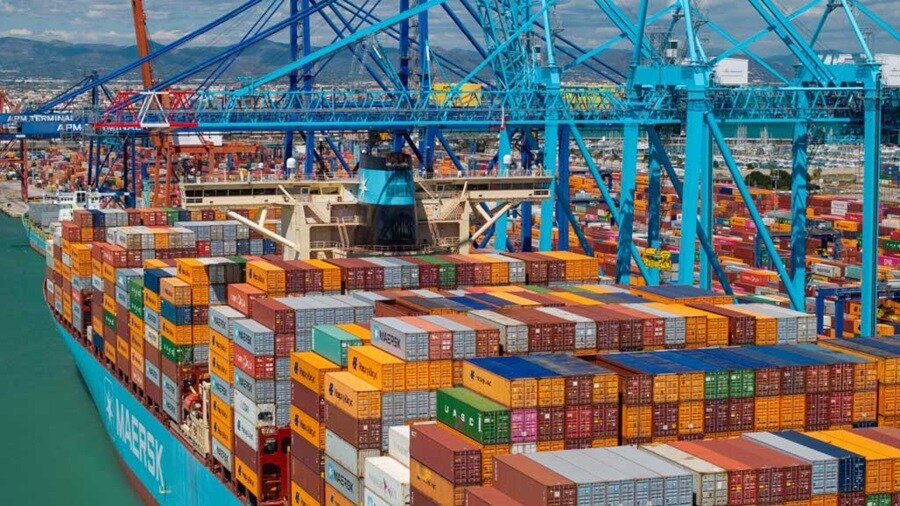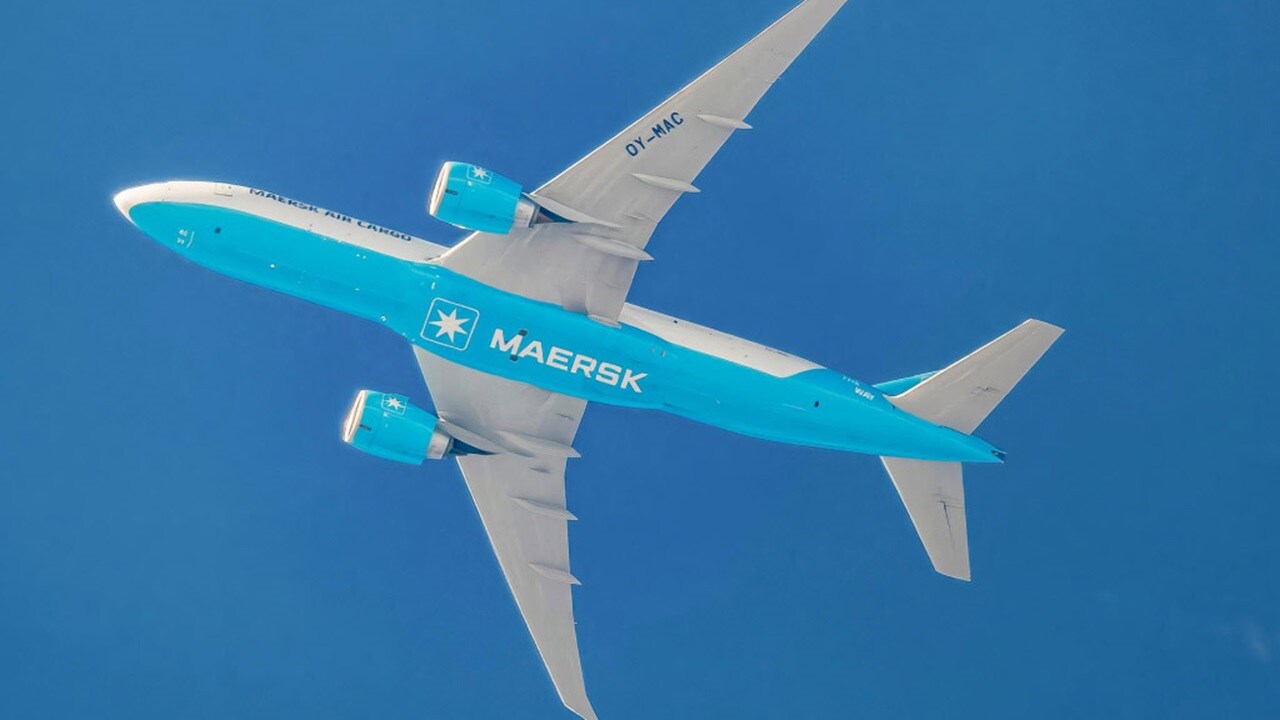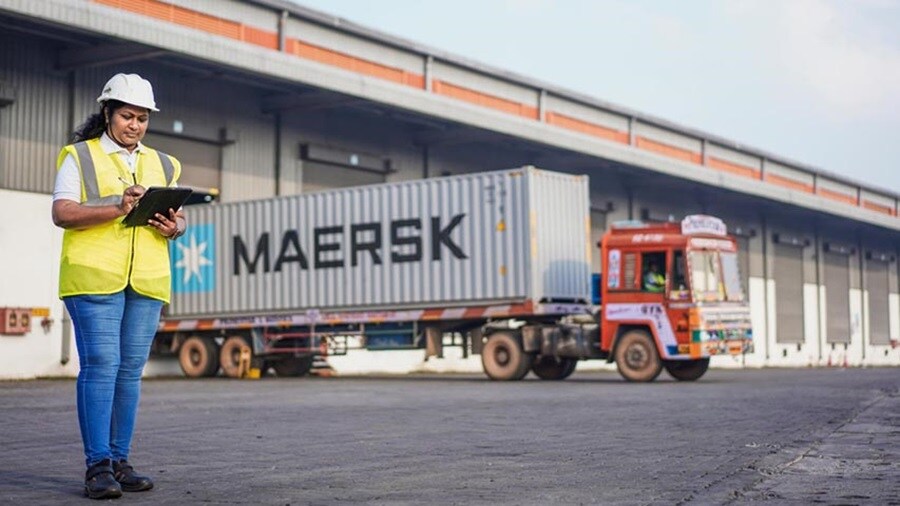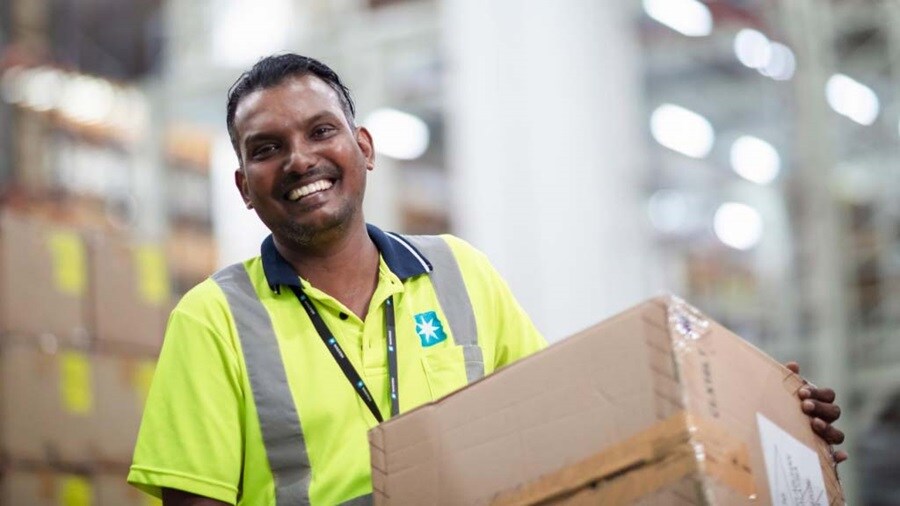As we move further into 2025, the Asia Pacific logistics landscape continues to be shaped by geopolitical developments, evolving trade policies, and shifting demand patterns. While ocean and air freight volumes remained resilient in early Q1, new tariff regimes and market uncertainty are beginning to reshape customer behaviour and cargo flows. At Maersk, we remain focused on helping our customers navigate these complexities with agility, transparency, and integrated solutions across ocean, air, inland, and Customs. This month’s update provides the latest insights across key transport modes, spotlighting the impact of current policy shifts and outlining how we’re supporting customers in building more flexible, resilient supply chains.
Download the flyer in Chinese language:
Ocean Market Update
Global Ocean Container Trade Maintained Solid momentum in Q1

Global ocean container trade maintained solid momentum , with volumes growing 4.7% year- on-year between December and February, according to Maersk Strategic Insight. Far East Asia remained a key driver of growth, with sus- tained export activity supporting higher import volumes into Latin America, Europe, and North America. In contrast, imports into Far East Asia declined by 7.4%, reflecting post–Lunar New Year softness and a continued drawdown of existing inventories. Despite seasonal easing in March, export flows from Asia to the U.S. and Europe remained steady, though the overall environment has become more complex.
Amid Shifting Market Dynamics, Maersk remains committed to maintaining a stable and reliable schedule for our customers
The volatility and complexity of the shifting policy landscape places global logistics at the forefront as the effects of trade tensions reinforces the importance of agile and robust supply chains. We are in close contact with our customers navigating a volatile and uncertain business landscape. Many deploy a “wait and see” approach, keeping goods flowing as they work to clarify options to respond and mitigate based on a range of scenarios. Uncertainty remains the key challenge and until there is a clearer picture, we expect customers to be more cautious about their inventory levels and continue exploring ways to build additional flexibility into their supply chains.
Recent months have also seen an increased number of cancelled sailings on the Transpacific trade. According to Sea-Intelligence, the overall deployed capacity on Transpacific routes has already been reduced by 19% as of date and may accelerate further in the coming weeks.
Amid shifting market dynamics, Maersk remains committed to maintaining a stable and reliable schedule for our customers.
In a time of heightened uncertainty, maintaining a predictable and dependable network is critical for our customers’ supply chain planning. Maersk has to date prioritized operating a full sailing program on the Transpacific corridor, while we in some cases sail smaller vessels to release the larger ones for trades with higher demand
Despite the market experiencing adjusted schedules and blanked sailings, Maersk to date has maintained a full sailing schedule across the Transpacific corridor, prioritizing reliability and resilience for customers. Our newly launched East-West network combines mainliner strength with shuttle agility, ensuring consistent and dependable services across Asia Pacific even amid ongoing volatility.
The impact of new tariffs will increasingly shape the outlook for the Intra-Asia market, which experienced strong demand through the first quarter of 2025. These tariffs may affect the movement of raw materials and semi-finished goods destined for re-export to global markets. Maersk is actively monitoring these developments and maintaining flexibility in our network to respond quickly to shifting trade patterns.
Update on Schedule Reliability from Sea-Intelligence
We’ve achieved 90.3% schedule reliability in March, according to Sea-Intelligence – a strong milestone in the phase-in of our East-West Network under the Gemini Cooperation. We’re continuing to improve service reliability and efficiency for our customers.
Here’s what we’ve achieved so far:
- Network phase-in: All exports in each respective regions are now running on the new network.
- Continued reliability above 90%: We deliver towards our goal of schedule reliability above 90% once our network is fully phased in by June.
- Fleet Transition: Around 95% of the 340 vessels have joined the new network, and we’re on track to complete the full phase-in by mid-May 2025.
See the Sea-Intelligence press release here.
Update on the USTR Section 301 review
On April 17, 2025, the United States Trade Representative (USTR) concluded its Section 301 investigation into China’s maritime, logistics, and shipbuilding sectors. As a result, the U.S. government will begin phasing in higher fees on Chinese-owned and Chinese-built vessels calling U.S. ports. While the rule takes effect immediately, fees are set at $0 for the first 180 days and will begin increasing from October 14, 2025.
At this time, we do not see a direct cost from this initiative impacting Maersk or our customers. We do not anticipate changes to our U.S. port rotations due to the new fees. Your current service plans remain unchanged.
We are monitoring developments closely and will keep you informed. Thank you for your support of our services and please contact your Maersk representative if you require additional information. We’re here to help you plan ahead.
Air Freight Market Update
Strong Start for Air Freight in Asia Pacific, but Policy Shifts and Demand Volatility Loom

Asia Pacific’s air freight market began 2025 with strong momentum, supported by solid demand in the Lifestyle and Retail sectors. Global air freight forwarding volumes rose 7% year-on-year in January, according to Maersk Strategic Insight, though growth slowed to 1.2% in February due to weaker performance in Europe and West Central Asia. Intra-Asia trade remained a bright spot, with volumes rising 13.3% year-on-year in February, underscoring the region’s resilient intra-regional demand.
A notable policy shift is now affecting shipments into the U.S. from Mainland China and Hong Kong SAR. As of 2 May, the de minimis exemption – which previously allowed goods valued under USD 800 to enter duty-free – has been revoked. Shipments are now subject to duties calculated at 90% of item value or a USD 75 flat rate per item, with this rate set to increase to USD 150 from 1 June. This change carries significant implications for e-commerce and small parcel shippers operating on U.S.-bound air freight lanes, particularly those reliant on low-value, high-volume flows.
To ensure continuity and resilience in customer supply chains, Maersk is actively managing capacity across Asia Pacific lanes and monitoring demand trends. We are working closely with customers likely to be affected by U.S. import changes, offering guidance on customs planning, cost mitigation, and alternative routing where necessary.
For customers shipping from Mainland China or Hong Kong SAR to the U.S., we recommend reviewing logistics strategies to minimise potential cost and clearance impacts. Early booking remains key, particularly on routes into Europe and the Americas. Maersk teams are available to assist with tailored solutions and space planning.
Inland Market Update

Inland logistics across Asia Pacific continues to adapt to evolving supply chain demands, with increased emphasis on end-to-end visibility, operational efficiency, and resilience. As trade flows adjust in response to shifting sourcing strategies and external policy developments, inland networks are playing a critical role in ensuring seamless cargo movement.
The recent implementation of U.S. tariff measures has introduced fluctuations in shipment planning, particularly across key export markets. Despite these changes, inland transportation in the region remains stable. Trucking, barge and rail services in Greater China are operating smoothly, supporting consistence and reliable inland flows.
Maersk has recently launched Maersk Arc, a real-time track and trace system for Full Container Load (FCL) trailers in intermodal service. This system enables tracking of import/ export trailer services operated by Maersk within Greater China. It provides intelligent alerts in case of logistics exceptions, empowering customers to monitor logistics dynamics promptly and accurately, thereby facilitating informed supply chain decisions.

Customs Market Update
Recent tariff developments imposed uncertainty and complexity to supply chain planning. As of April 10, 2025, the U.S. Customs and Border Protection has implemented a significant increase in duties on imports from Mainland China, Hong Kong SAR, and Macau SAR – applying an additional 125% ad valorem tariff on top of the existing 20% rate. While certain goods may be exempt, the broader implications for shippers are considerable, particularly for those engaged in e-commerce, electronics, and consumer goods exports.
On April 11, 2025, China’s Customs Tariff Commission of the State Council announced an adjustment to tariff measures on imports originating from the United States from 84% to 125%, with effect from April 12, 2025.
The European Commission released a statement on April 10, 2025 by President von der Leyen, wherein the President stated that in response to the U.S. suspension of previous country-specific tariffs, the EU countermeasures are put on hold for 90 days. She further stated that if negotiations are not satisfactory, countermeasures will kick in. European Commission preparatory work on potential further countermeasures continues.
These changes represent a shift in U.S. trade policy and China trade policy, and may impact your landed costs, customs clearance procedures, and overall supply chain planning. We recommend reviewing your current sourcing strategies, assessing tariff exposure, updating landed cost models based on the new duty rates and ensuring your customs documentation, country of origin and classifications (HTS/HS codes) are accurate and up to date.
These changes may have an impact on your supply chain. Maersk’s Trade Services team can support you with tariff impact analysis, customs compliance planning, supply chain risk reviews and Invoice structure updates. If you need assistance regarding China regulations, please contact us at: GTCCAPA@maersk.com
As the situation regarding tariffs is rapidly changing, we want to make sure you have the correct information gathered in one place, with easy access. Therefore, we have created a tariff web page where you can see official changes to tariffs.
Major Ports Update
| Trade | Less than 1 day | 1-3 days | More than 3 days |
|---|---|---|---|
|
Trade
Asia Ports
|
Less than 1 day
Busan, Dalian, Xingang, Xiamen, Shekou, Yantian, Nansha, Hong Kong, Tanjung Pelepas, Singapore, Sydney, Brisbane, Auckland, Melbourne
|
1-3 days
Qingdao, Shanghai, Ningbo, Ho Chi Minh, Jakarta, Port Klang, Tauranga
|
More than 3 days
|
|
Trade
Rest of World
|
Less than 1 day
Bremerhaven, Rotterdam, Valencia, Jebel Ali, Colombo, Apapa, Onne, Tema, Lome, Conakry, Maputo, Durban, Zanzibar, Pointe Noire, Cape Town, Oakland, Los Angeles, Prince Rupert, Vancouver, Tacoma, Houston, Norfolk, Baltimore, Charleston, Miami, Newark,Balboa
|
1-3 days
Rijeka, Koper, Abidjan, Dar es Salaam, Savannah, Lazaro Cardenas
|
More than 3 days
|
Remark: Information is dynamic and subject to change.
Resources and tools to support you
Explore the Maersk Logistics Trend Map: Your Guide to the Future of Global Supply Chains Maersk, in collaboration with leading data provider Statista, has launched the Logistics Trend Map – a dynamic, interactive tool designed to help businesses navigate the rapidly evolving logistics landscape. This digital platform highlights the most influential trends shaping global and regional supply chains today. From digital transformation and decarbonisation to shifting trade patterns and supply chain resilience, the map offers a clear overview of developments impacting logistics strategies worldwide. Whether you’re planning for future disruptions or looking to identify growth opportunities, the Logistics Trend Map provides timely insights to support informed decision-making. You can explore the Logistics Trend Map by click here. Stay ahead of the curve with Maersk’s data-backed intelligence.
Visit our “Insights” pages where we explore the latest trends in supply chain digitization, sustainability, growth, resilience, and integrated logistics.
Learn what’s happening in our regions by reading our Maersk Europe, North America, and Latin America updates.
Do you find this market update useful? If you haven’t subscribed to Maersk Asia Pacific Monthly Update yet, click the link below and stay posted!
Subscribe to Asia Pacific Monthly Updates
We value your business and welcome your feedback. Should you have any questions on optimizing your cargo flows, please contact your local Maersk professional.
Anything you need, we’re here to help
I agree to receive logistics related news and marketing updates by email, phone, messaging services (e.g. WhatsApp) and other digital platforms, including but not limited to social media (e.g., LinkedIn) from A. P. Moller-Maersk and its affiliated companies (see latest company overview). I understand that I can opt out of such Maersk communications at any time by clicking the unsubscribe link. To see how we use your personal data, please read our Privacy Notification.
By completing this form, you confirm that you agree to the use of your personal data by Maersk as described in our Privacy Notification.


